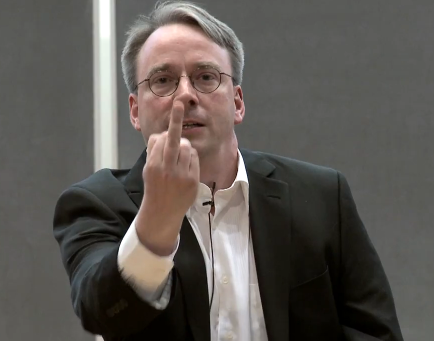Nvidia Issues Diplomatic Response to Linus Torvalds' F-Bomb
Nvidia's approach to support or not support driver development for Linux has been questioned for some time. So, Linus Torvalds' recent attack on Nvidia was not exactly surprising. Nvidia's answer is not surprising either.
Nvidia's public relations department has issued a response of rather diplomatic nature and surely does not indicate that the graphics company is changing direction. The lengthy answer is an explanation of what Nvidia is attempting to achieve with its Linux driver support (or lack thereof) along with a friendly, corporate version of Torvalds' choice of words to express his dissatisfaction with the company.
"At the end of the day, providing a consistent GPU experience across multiple platforms for all of our customers continues to be one of our key goals," the answer states in its last sentence and pretty much sums up Nvidia's intent, while the company says it understands that "there are people who are as passionate about Linux as an open source platform." In more detail:
"While we understand that some people would prefer us to provide detailed documentation on all of our GPU internals, or be more active in Linux kernel community development discussions, we have made a decision to support Linux on our GPUs by leveraging NVIDIA common code, rather than the Linux common infrastructure. While this may not please everyone, it does allow us to provide the most consistent GPU experience to our customers, regardless of platform or operating system."
Additionally, Nvidia stated that it is heavily involved in the Linux community in various ways, including the ARM Linux kernel team. The note also stressed that Nvidia "ranks second in terms of total lines changed and fourth in terms of number of changesets for all employers or organizations" for the latest 3.4 ARM kernel.
Below is the full response:
Supporting Linux is important to NVIDIA, and we understand that there are people who are as passionate about Linux as an open source platform as we are passionate about delivering an awesome GPU experience. Recently, there have been some questions raised about our lack of support for our Optimus notebook technology. When we launched our Optimus notebook technology, it was with support for Windows 7 only. The open source community rallied to work around this with support from the Bumblebee Open Source Project http://bumblebee-project.org/. And as a result, we've recently made Installer and readme changes in our R295 drivers that were designed to make interaction with Bumblebee easier. While we understand that some people would prefer us to provide detailed documentation on all of our GPU internals, or be more active in Linux kernel community development discussions, we have made a decision to support Linux on our GPUs by leveraging NVIDIA common code, rather than the Linux common infrastructure. While this may not please everyone, it does allow us to provide the most consistent GPU experience to our customers, regardless of platform or operating system. As a result: 1) Linux end users benefit from same-day support for new GPUs , OpenGL version and extension parity between NVIDIA Windows and NVIDIA Linux support, and OpenGL performance parity between NVIDIA Windows and NVIDIA Linux. 2) We support a wide variety of GPUs on Linux, including our latest GeForce, Quadro, and Tesla-class GPUs, for both desktop and notebook platforms. Our drivers for these platforms are updated regularly, with seven updates released so far this year for Linux alone. The latest Linux drivers can be downloaded from www.nvidia.com/object/unix.html. 3) We are a very active participant in the ARM Linux kernel. For the latest 3.4 ARM kernel – the next-gen kernel to be used on future Linux, Android, and Chrome distributions – NVIDIA ranks second in terms of total lines changed and fourth in terms of number of changesets for all employers or organizations. At the end of the day, providing a consistent GPU experience across multiple platforms for all of our customers continues to be one of our key goals.
Get Tom's Hardware's best news and in-depth reviews, straight to your inbox.

Douglas Perry was a freelance writer for Tom's Hardware covering semiconductors, storage technology, quantum computing, and processor power delivery. He has authored several books and is currently an editor for The Oregonian/OregonLive.
-
vmem well... it looks like we're back to where we started... somehow Nvidia's PR response seems to imply they're not going to change anything from what they've been doing in the pastReply -
whooleo I'm pretty sure nVIDIA has had much better driver support than other companies *COUGH* AMD*COUGH* so Linus needs to stop b****ing because nVIDIA drivers work pretty good under linux open source or not. This guy is just a clown I tells ya!Reply -
bluekoala My guess is if either AMD or nVidia had grade A support for Linux, a lot of new rogue gaming and media consoles would appear on the market. Much like what we're seeing with android and how it's fueling innovation. Everyone wants a slice of the market so they are motivated to introduce new unique features; bigger/smaller, better and cheaper.Reply
Whereas on the windows platform, due to it closedness, it would be hard to conceive that new typed of Windows devices could emerge from a garage.
Speaking of which, I'm going to see if there's any news on that "Steam console" I've been hearing rumors about. -
alidan bluekoalaMy guess is if either AMD or nVidia had grade A support for Linux, a lot of new rogue gaming and media consoles would appear on the market. Much like what we're seeing with android and how it's fueling innovation. Everyone wants a slice of the market so they are motivated to introduce new unique features; bigger/smaller, better and cheaper.Whereas on the windows platform, due to it closedness, it would be hard to conceive that new typed of Windows devices could emerge from a garage. Speaking of which, I'm going to see if there's any news on that "Steam console" I've been hearing rumors about.Reply
most people get windows with their pc, and microsoft doesnt charge to make a windows game.
the only difference dev side is that linus makes up about 1% and even than, they are not gamers to begin with, and they want to move as far away as possible from pc if they can help it... so intensive isnt there. -
-Fran- This is not only about support, but how the company "opens up" to the Linux community. That's one huge difference.Reply
I actually think nVidia is doing a some-what good job with Linux, but for all the things they should be doing, is not enough if they're going to keep things closed to the rest. In that particular note, AMD is way better than nVidia (AFAIK) since they provide detailed spec sheets of their GPUs and, more often than not, use open technologies.
Cheers! -
Filiprino I don't know why so much has been made of the Linus' statement.Reply
NVIDIA may not be very friendly to free software development, but at least they provide a good closed driver.
Also, we've to remind that Linus didn't use GPL license because it granted freedom, but because it helped him to make his kernel widespread. As such, he doesn't want to switch to GPLv3, because companies prefer GPLv2 due to it having a flaw that allows them to use the source code, redistribute it but users are unable to use a modified versions of that source code because the device needs the binary to be signed or whatever other protection you can imagine.
On other topic, I'll take a look again to bumblebee. It can work, but it's not a native solution and it sucks a bit. -
vmem whooleoI'm pretty sure nVIDIA has had much better driver support than other companies *COUGH* AMD*COUGH* so Linus needs to stop b****ing because nVIDIA drivers work pretty good under linux open source or not. This guy is just a clown I tells ya!seriously? on a PC, sure I agree with you. but for Linux? Nvidia's the equivalent of apple, keeping everything behind closed doors and secret curtains. sure they pump out drivers, but without full spec sheets of their GPU dies, it doesn't do much for the software engineers behind all the Linux systems...Reply
also, Linus may have gone a bit overboard just to make headlines, but he's still a legend in his own right... just a clown? I'm sure if you did a simple poll of you vs Linus 99% will vote you're the clown -
bluekoala YukaThis is not only about support, but how the company "opens up" to the Linux community. That's one huge difference.I actually think nVidia is doing a some-what good job with Linux, but for all the things they should be doing, is not enough if they're going to keep things closed to the rest. In that particular note, AMD is way better than nVidia (AFAIK) since they provide detailed spec sheets of their GPUs and, more often than not, use open technologies.Cheers!Reply
This is somewhat true. AMD has FGLRX driver wich is proprietary and they also release documentation and provided resources to work on an open driver. The problem with the open source driver is that it does not have the same performance. The problem with proprietary driver is that it cannot be adapted very well to different environments by anyone else than the manufacturer. Since the manufacturer doesn't have or want to spend the resources necessary to make all the changes for every possible request then this driver is useless is many scenarios. And on the other hand, a lot of users are not willing to use the open driver because this means they will not be able to exploit the potential of their hardware. In Nvidia's case, there really isn't much of an option for an open driver so if their driver isn't doing what you want it to do you are screwed. For the average user who would install ubuntu to read e-mails and check facebook and maybe play the occasional OpenGL game or even gaming through WINE, this isn't an issue.
That's how I see it anyway.
